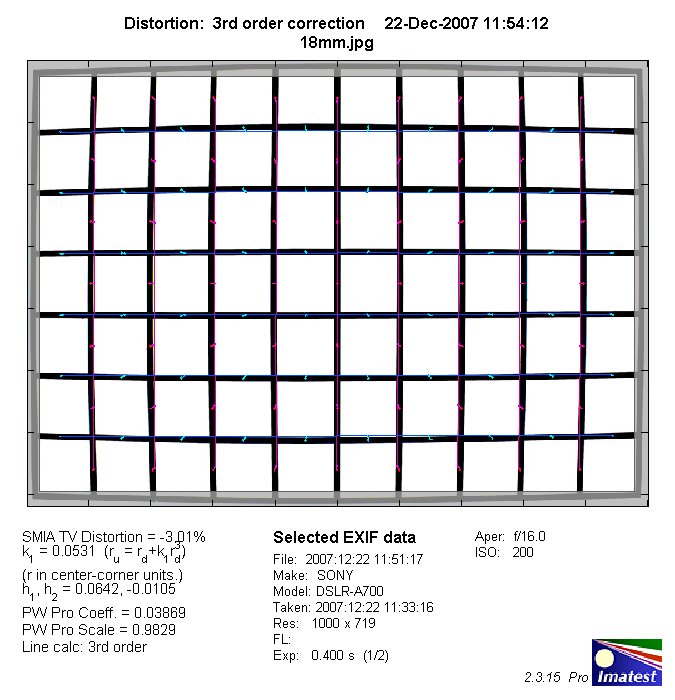|
Sony 18-70mm f/3.5-5.6 DT ( SAL-1870 ) - Review / Lab Test Report - Analysis |
|
Lens Reviews -
Sony Alpha/NEX (APS-C)
|
|
Page 2 of 2

Distortion
Typical for many standard zoom lenses the Sony produces quite hefty barrel distortion at
18mm (~3%) which decrease continuously towards the long end of the zoom range where the
lens is basically free of distortion.
|
Move the mouse cursor over the focal length text marks below to observe the respective distortion
|
| 18mm |
24mm |
40mm |
70mm |
|

|
The chart above has a real-world size of about 120x80cm.
Vignetting
Due to its APS-C image circle the Sony 18-70mm produces some vignetting at 18mm and
wide-open aperture but generally the issue is surprisingly well controlled for such a
lens. At 18mm @ f/3.5 the situation is worst with a vignetting of about 1EV whereas at all
other tested settings it is not really a problem anymore.

MTF (resolution)
The Sony 18-70mm f/3.5-5.6 DT produced rather mixed resolution results in the MTF lab.
At 18mm the lens is able to provide comparatively decent results with a very high
center resolution and good to very good borders. At 24mm the center performance
remains very high but the borders quality drops significantly especially when looking
at the extreme corners and stopping down doesn't really change the situation.
In the medium range (40mm) the performance is decent throughout the tested aperture
range. At 70mm there's quite a downtrend again specifically at f/5.6. Stopping down
lifts the quality to very good results though. At f/5.6 the contrast level is also
just so so here.
The Imatest toolkit had quite some problems to provide reliable resolution results
for this lens. Normally CAs are compensated but this Sony lens has rather extreme
problems here (see the next chapter). Uncorrected CA can produce a visually softer
image so if you prefer to shoot JPEGs straight from the camera the images will certainly
look worse than suggested by the charts below.
Please note that the MTF results are not directly comparable across the different systems!
Below is a simplified summary of the formal findings. The chart shows line widths per picture height (LW/PH) which can be taken as a measure for sharpness.
If you want to know more about the MTF50 figures you may check out the corresponding Imatest Explanations
Chromatic Aberrations (CAs)
Lateral chromatic aberrations (color shadows at harsh contrast transitions) are
a drastic problem. At 18mm and 24mm the amount of the CAs did not fit into the usually
chosen scale thanks to a peak width of up to 4px on the average at the image borders.
This is extremely poor. CAs are relatively moderate at 70mm. Please note than lateral
CAs can be largely reduced via imaging tools - certainly a good idea here.

For your enjoyment ... here's a 100% border crop of the test chart illustrating the problem:

Verdict
The Sony 18-70mm f/3.5-5.6 DT is a cheap kit zoom with sells around 100 €/US$ and
this is also an indication for what you can expect from this lens. Technically the
resolution figures are decent at 18mm and 40mm - less so at 70mm and especially at 24mm.
Distortions and vignetting are about in line with the rest of the gang, maybe even slightly
better. However, lateral CAs (parasitary color shadows at the image borders) are extremely
pronounced with a width up to 4(!)px on the A700. This should be a show-stopper for those
who prefer JPEGs straight from the camera because lateral CAs do also reduce the perceived
sharpness. This may still have all worked out on the old 6mp DSLRs years ago but on an
Alpha 100 and Alpha 700 this is far beyond the edge. Mechanically it is one of the better
kit zoom lenses out there but it isn't something to rave about either. If your budget permits
you should probably go a little up the food chain and check out lenses like the
Sigma AF 17-70mm f/2.8-4.5 or one of the higher grade Sony/Zeiss standard zooms a la Sony 16-105mm f/3.5-5.6 DT.
|